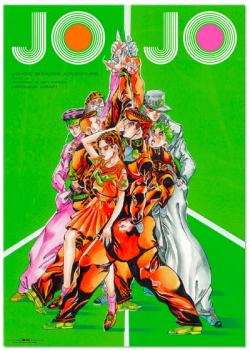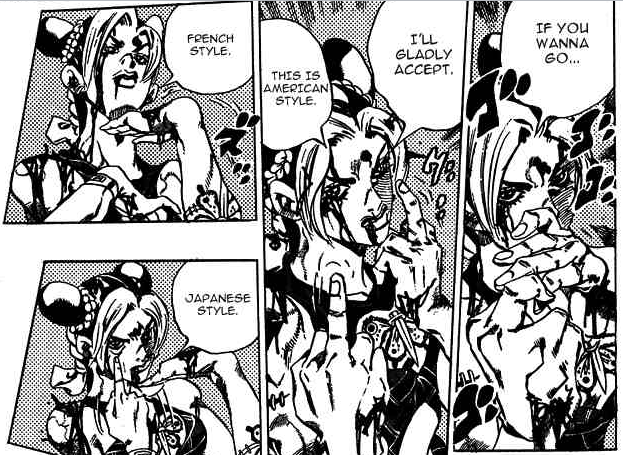Well, to be specific, I’m talkin’ about Jojo’s Bizarre Adventure parts 4 and 6. If you’re following the anime adaptations but not the manga, there will be spoilers, though I’ll try to keep them under toggle. (Click the tiny pluses to show them!)
In the last, oh, six months or so, I’ve been revisiting parts of Jojo I haven’t read in quite some time – stuff that hasn’t yet seen an anime adaptation, and won’t be published officially in English for a good while yet. I read through all of part four again and am a little over halfway through part six. I feel like it’s always good to revisit stuff like this after a long period, because it lets you re-examine it under the different perspective that years of partaking in other media gives you. In my case, re-reading Jojo part 4 after having played Persona 4 was rather eye-opening: it’s very clear the influence the former had on the development of the setting and progression of the latter. That’s not to say P4 wholly ripped off JJBA in an unflattering way – rather, it utilizes a lot of the same elements that make this portion of the manga so great to make one of the best JRPGs of the last decade.
In fact, I remember not liking Part 4 all that much when I first went through it, but now that I’ve finished it off again it might be my favorite piece of Jojo in terms of how it handles its setting and character development.
There’s an interview with Araki (some spoilers) released around the time of the (awful) PS2 Phantom Blood game, where he discusses some of the thought that went into the various parts of Jojo up until that point. One of the things he mentions is how Josuke is different in terms of reader relatability to Jotaro: Where Jotaro is this stoic, almost mythical hero in part three, Josuke is more like your cool best friend who you love just doing fun stuff with. Other characters in part 4 give a similar feeling to the reader: despite their supernatural Stand powers, they’re not the incredible superhumans from part 3, they’re just the collection of unique faces in town who happen to have special abilities.
Part of the reason why the characters come across like this is that 4 isn’t afraid to take some time off from its main plotlines, devoting many chapters to the people who make up the population of Morioh and their odd little escapades. In some stories, this would be nothing more than filler, but here, it works spectacularly. By devoting a good chunk of time to building up Morioh as a place filled with distinct, enjoyable (and not-so-enjoyable) characters, Araki creates a setting that you grow invested in. By filling in little stories and details about characters’ lives, he shows that there’s an ecosystem of personalities in Morioh and that it’s worth the extreme struggles the heroes are going through to restore peace to the town.
Remember how I was saying that P4 utilizes a lot of the same elements of Jojo part 4? I don’t mean just in terms of the “serial killer creates chaos in a sleepy town in Japan’s countryside and superpowered high school kids save the day” plot stuff – the way P4 creates a character for Inaba itself is similar to how Araki builds Morioh. Inaba and Morioh are both entities in themselves. The many odd episodes focusing on encounters with people in these places – the heroes going on trips or doing the school culture festival, the many Social Links you can engage in – aren’t just an amusing distraction from the main plot: they are a vital part of what makes these settings so special. Taking that time away from the central plot to develop characters and their relationships is why we care so much about the endgame plight of the city and its citizens in P4, and the heroes putting an end to the ongoing chaos in Jojo part 4.
On that note, I recall a key point from Danganronpa scribe Kazutaka Kodaka’s GDC 2015 presentation: it’s important for the author to love the characters they create in order to write them effectively. I get that feeling with part 4 especially, going all the way down to the central villain.
In the interview I linked above, Araki also talks a bit about making the reader feel a bit sympathetic towards Kira, in spite of him being a complete psychopath. Araki really does have a talent for making appealing villains (Dio is one unbelievably charismatic bastard) and I think it comes from the same place as Kodaka’s sentiment: because Araki loves his villain characters as he loves his heroes, he’s able to make them effective and memorable as enemies. You can see this in some of the episodes where it’s solely focused on Kira, such as him bonding with the cat-plant-monster – there’s a weird humanity to him, as completely messed up as it seems to us.
The affection Araki has for his creations really come through to the reader in part 4, and that’s why, upon re-reading it, I feel it’s definitely one of the best portions of the whole series.
I’m about halfway through revisiting part 6 right now. I always considered this part my favorite, and there are many reasons why: it’s what was running when I was first getting into the series, it was the first chapter to put a female character is the starring role (and, most importantly, let her beat the shit out of everybody in prime Jojo fashion), and it continued the ongoing “Joestar bloodline versus Dio” plotline we all loved from part 3.
Re-reading it now, I think it’s still my favorite for one major reason: it’s got my favorite central cast out of all the chapters. Obviously, my affection for tough-as-hell ladies punching dudes leaves me a built-in affection for characters like Jolyne and Hermes, but I feel like there’s a bit more to it than that. I’m the type of person who values character personalities and their interaction over plot – if you have distinct, fun characters interacting with each other in interesting and enjoyable ways, I couldn’t really care how flimsy the plot is at points. (I’ve always maintained that this is how I can tolerate the usually-awful stories of the Tales series – the characters absolutely carry those games.) Create a good cast and a premise that brings out the best in them, and I’ll be more than happy to join in on the ride.
 In terms of story and general event-to-event progression, I’ll admit that part 6 is quite weak. The characters, however, are what really endears it so much to me. I obviously love Jolyne and Hermes a lot, but there’s also something really endearing about the sheer weirdness of the hero characters who come into play later on like Weather Report and Annasui and how they engage with everybody else. There’s a lot of character development for Jolyne over the course of the story, too, as she comes to understand her difficult relationship with her father in the most grueling way possible. Jojo leads like Jotaro and Giorno feel fairly static throughout their respective turns in the spotlight, whereas Jolyne feels like she’s grown and learned considerably even just a few volumes in.
In terms of story and general event-to-event progression, I’ll admit that part 6 is quite weak. The characters, however, are what really endears it so much to me. I obviously love Jolyne and Hermes a lot, but there’s also something really endearing about the sheer weirdness of the hero characters who come into play later on like Weather Report and Annasui and how they engage with everybody else. There’s a lot of character development for Jolyne over the course of the story, too, as she comes to understand her difficult relationship with her father in the most grueling way possible. Jojo leads like Jotaro and Giorno feel fairly static throughout their respective turns in the spotlight, whereas Jolyne feels like she’s grown and learned considerably even just a few volumes in.
That sort of character growth is seen in a lot of the other heroes of part 6, as well. One of my absolute favorite things about part 6 is the character arc of F.F.
F.F. is given intelligence and sentience by sheer accident, and feels obligated to protect the interests of the person who gave her those things. Though she is intelligent, she is emotionally immature. Jolyne realizes this and spares her life when their battle ends, knowing that F.F. isn’t truly malicious. From there on she develops and grows with the help of her new friends, discovering important concepts that establish her humanity. (A bit of a strange phrase, given that she’s decidedly inhuman, but I think you understand.) It’s her friends, and the memories she has shared with them, that makes her a complete being, and when she is dying and Jolyne says that they can revive her, she points out that the person Jolyne would “resurrect” wouldn’t be her because of the development she had from her time spent with them. Her greatest fears were losing her new self and losing the memories of her friends that had made her whole, and she was okay with dying if it meant holding onto those until the end.
I really wonder how I’ll feel about the somewhat-contentious ending to part 6 when I get to it again. As I get older, I feel like endings to media that seemed iffy when I first encountered them are a lot better upon a revisit. Maybe this will be the case with part 6.
But no matter what, Jolyne will always be best Jojo to me.





I really agree with all the points made with this article. Araki is really talented at filling his characters with these distinct personalities that stick with you.
And unrelated, for me top 3 parts have to be Part 7, Part 6 and then part 4.
Man this is really after the fact. I should really come check this site out more than just after I re-listen to your appearances on Laser Time.
First off, It will always be Duwang in my heart. “Duwang such beautiful city” should be the slogan. When talking about JoJo villains, I feel Kira really does stand out because of how involved he is every step of the way. You first encounter him having a lovely picnic with his hand/girlfriend. You see him trying to fit into his new life and dealing with the family he stole. Stardust Dio doesn’t show up to the end though he is menacing the whole time, Diavolo is purposefully a mystery, and the priest Pucci is cool and all, but his hiding of his identity isn’t as interesting since he never stole a man’s face.
I never thought about how similar Persona 4 and JoJo part 4 are, but in retrospect it makes so much sense. You have delinquents (Josuke/Kanji) you have local eateries (that Chinese place/the Italian restaurant that blows you for a 5 star course) and local wildlife (Foxes that guard a shrine/rats that melt your flesh). While the innocent bystander death rate is much higher in JoJo, I do understand the point of how both towns feel developed so that the reader can imagine what a day in the life of someone from Inaba/Duwang would be like. Going to school then hanging at Junes or visiting Angelo the rock and later walking down an alley that leads to oblivion. Small towns rule!